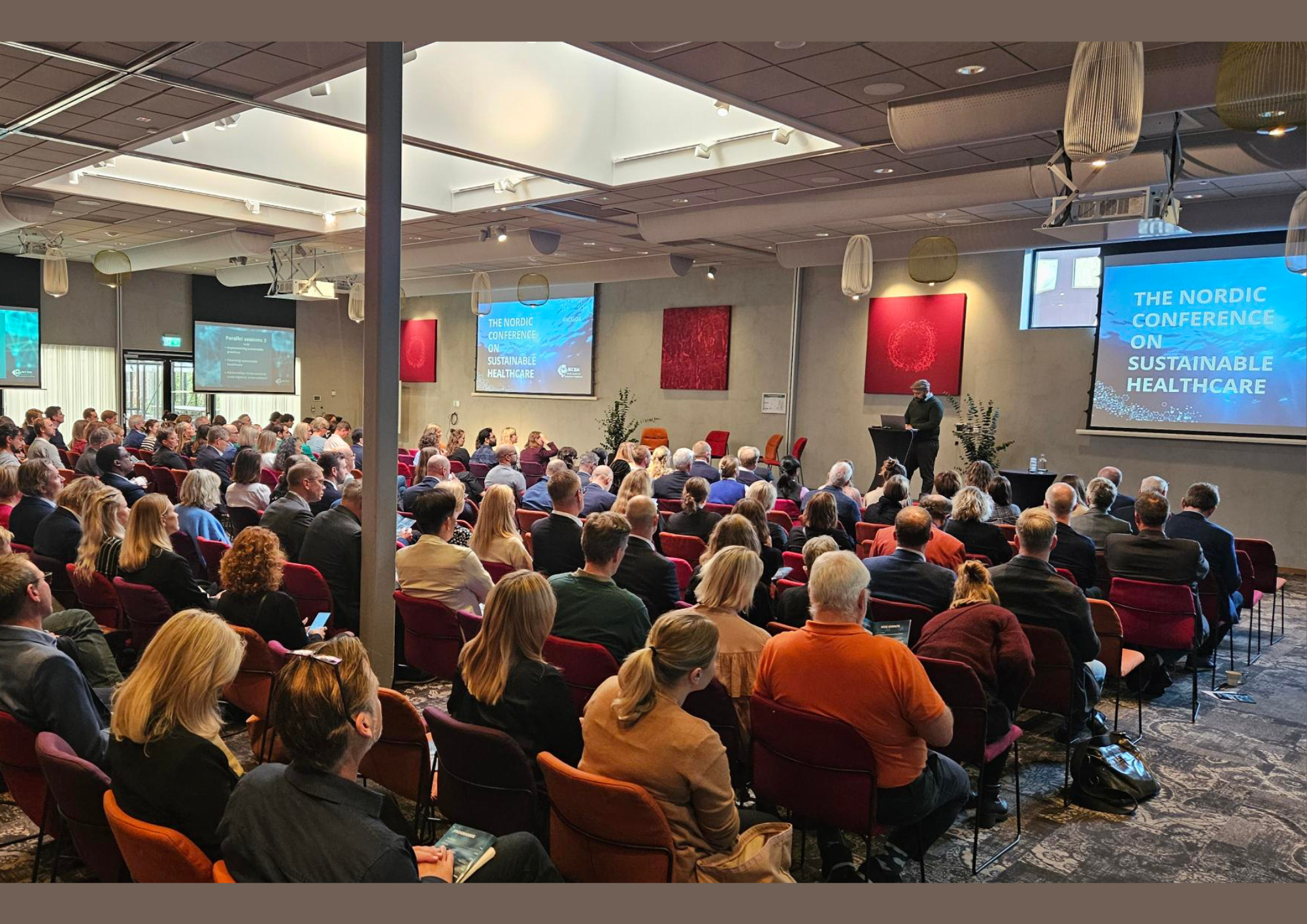A global call to action: The 7th Nordic Conference on Sustainable Healthcare kicks off in November 2025, co-creating a new blueprint for sustainable healthcare
Why is the world focusing on sustainable healthcare?
What exactly is sustainable healthcare?
Leading global examples of sustainable healthcare
Join the 7th Nordic Conference on Sustainable Healthcare
Introduction
According to the WHO's 2025 report, deaths from cardiovascular diseases triggered by heatwaves have increased by 60% in the past decade. Meanwhile, greenhouse gas emissions from healthcare systems themselves are becoming an accomplice to the very diseases they seek to cure. The global healthcare sector accounts for 4.6% of total carbon emissions - twice that of the aviation industry - with operating rooms alone contributing 33% of total institutional emissions.
This "treat-to-pollute" paradox has created a vicious cycle.
As WHO Director-General Tedros Adhanom Ghebreyesus stated, "Carbon emissions are the pathogen of this health crisis." The healthcare industry has become an accelerator of the climate crisis, eroding the health gains it once brought.
Why is the world focusing on sustainable healthcare?
Globally, the amount of medical resources wasted each year through over-testing and excessive use of disposable instruments could meet the basic healthcare needs of 1.5 billion people. In China, only 10% of tertiary hospitals are equipped with waste management systems, turning medical consumables into a heavy environmental burden.
Climate-related health issues now cause an annual global economic loss of USD 1.6 trillion. Yet examples like Shanghai's Huashan Hospital, which redirected savings from energy retrofits into equipment upgrades, prove that "transform or go bankrupt" is no longer a metaphor but a financial reality.
Unsustainable healthcare models are rapidly depleting limited resources and creating systemic risks. Therefore sustainable healthcare is not a choice, it is the only path to stop the bleeding of healthcare systems and sustain human life.
As emphasized in multiple WHO reports on Climate Change and Health, reducing greenhouse gas emissions is, at its core, a comprehensive public health intervention.

What exactly is sustainable healthcare?
Sustainable healthcare is not a new concept. Nordic countries have long been pioneers in addressing environmental and social challenges in this field and China began cooperation with the Nordics on sustainable healthcare in 2020.
In simple terms, sustainable healthcare is a new model that achieves a balance between health and the environment across the entire healthcare lifecycle through policy, technology, and management.
It comprises three dimensions of sustainability: environmental, service, and economic.
Environmental sustainability includes decarbonized operations, waste recycling, and supply chain restructuring.
Example: Huashan Hospital installed solar panels and smart air-conditioning systems, reducing CO₂ emissions by 2,500 tons and improving energy efficiency by 29%.
Example: The Nordic "Closing Gaps" project optimized upstream pharmaceutical production, cutting waterborne drug residues by 40%, while Swedish firms developed biodegradable surgical tools, enabling "zero-waste operating rooms."
Service sustainability focuses on efficient, precise medical care such as community-based health management to prevent disease, digital technologies to enhance operational efficiency, and policy design to bridge health equity gaps and share green medical technologies with developing countries.
Nordic innovations also dispel the myth that sustainability equals higher cost. For instance, Sweden's "Zero-Carbon Hospital" initiative reduced annual emissions from 12,000 tons in 2019 to 3,000 tons in 2024, cut landfill medical waste by 92%, and achieved full ROI from energy-efficiency investments in just three years.
Through these three structural dimensions, sustainable healthcare achieves three critical balances:
Health benefits vs. environmental impact: Delivering medical services while minimizing carbon emissions and ecological damage.
Service accessibility vs. resource efficiency: Reducing overmedicalization and waste, ensuring broader coverage through precision care.
Short-term treatment vs. long-term health value, shifting from "curing disease" to "preventing illness," lowering overall medical burdens through chronic disease management and health education.
This philosophy aligns closely with the concept of "green medicine." It represents not only a technological innovation but also an evolution in our understanding of health. As WHO defines it, "Health is not merely the absence of disease, but a state of complete physical, mental and social well-being."
Leading global examples of sustainable healthcare
The Nordic region stands as the global benchmark for sustainable healthcare.
In an interview with Daniel Eriksson, CEO of the Nordic Center for Sustainable Healthcare (NCSH) and The TEM Foundation at Lund University, three core principles behind Nordic leadership were identified:
Policy Foundations: From Top-Level Design to Ground Implementation
Sweden's 2014 Patient Act included “environmental friendliness” in hospital performance assessments, requiring all public hospitals to conduct carbon footprint audits every three years.
The Nordic Five allocate over 85% of their healthcare innovation budgets (more than 9% of GDP) to Green Healthcare Innovation Funds, financing energy retrofits, eco-device R&D, and other sustainability projects.
Technological Innovation: Demand-Driven Breakthroughs
Iceland's national electronic health record system cut redundant testing by 40%, reducing energy use and material waste.
Nordic hospitals have adopted “low-carbon surgical packages,” inspired by the Netherlands’ total intravenous anesthesia technology, which emits 82% less CO₂ than conventional methods.
Swedish firms lead the way in biodegradable medical materials. Their absorbable surgical sutures achieve 98% full degradation, cutting environmental residue by 90%.
Management systems: the NCSH model in action
The NCSH acts as the central hub coordinating sustainable healthcare across the Nordic countries, serving as a policy catalyst, innovation incubator, and global knowledge bridge.
Its competitive edge lies in the "Determine–Baseline–Action–Reference" (DBAR) four-pillar model, now a global framework for sustainable healthcare transformation:
Determine: Identify key emission and waste points via 200+ quantitative indicators.
Baseline: Build a dynamic database from Nordic healthcare data to set tiered targets.
Action: Provide modular toolkits: waste classification guides, energy-efficient procurement lists, and low-carbon care templates.
Reference: Update a Best Practice Library quarterly, now featuring 120+ case studies.
Through initiatives such as the Baltic "Closing Gaps" project (cutting pharmaceutical pollution by 40%), the Karolinska Hospital zero-carbon upgrade (achieving 100% renewable energy and 92% landfill reduction), and Norway's "Health Communities" project (reducing per capita healthcare emissions by 32%), NCSH demonstrates that environmental investment can increase both sustainability and patient satisfaction (up to 91%).
Its "industry–academia–research loop" has also led to the mass production of 15 types of biodegradable medical products, proving that systemic transformation, not isolated improvements, is the key to sustainable healthcare.
By bridging policy, technology, and cross-sector collaboration, NCSH has turned the Nordics into the world's living lab for green healthcare, exporting frameworks that are transforming sustainable healthcare from a Nordic choice into a global necessity.
Join the 7th Nordic Conference on Sustainable Healthcare

As a core member of the Global Sustainable Healthcare Alliance and lead author of the "2025 Sustainable Healthcare Trends Report," NCSH will host the 7th Nordic Conference on Sustainable Healthcare on November 12, 2025, in Sweden.
The conference will convene industry leaders from over 25 countries under the theme "Green Transformation in Healthcare", bringing together cutting-edge insights and actionable strategies to drive global sustainable healthcare progress.
The healthcare innovation industry is now thriving. Emerging startups and solutions are reshaping the landscape. Future healthcare innovation will be driven by digital health, sustainable medical technologies, climate-smart care, and circular healthcare systems.
Healthcare is evolving from "saving lives" to "safeguarding the life of our shared planet." Whether you are a hospital administrator, policy maker, or technological innovator, the 7th Nordic Summit in November will be a pivotal moment to translate global insights into systemic transformation.
Visit the Nordic Conference on Sustainable Healthcare official website for more information:
https://www.nordicshc.org/events/conference.html
As WHO Director-General Tedros Adhanom Ghebreyesus stated:
"Sustainable healthcare is not an option. It is a matter of survival."
This November in Sweden, let us build a future where healthcare and the planet thrive together.
